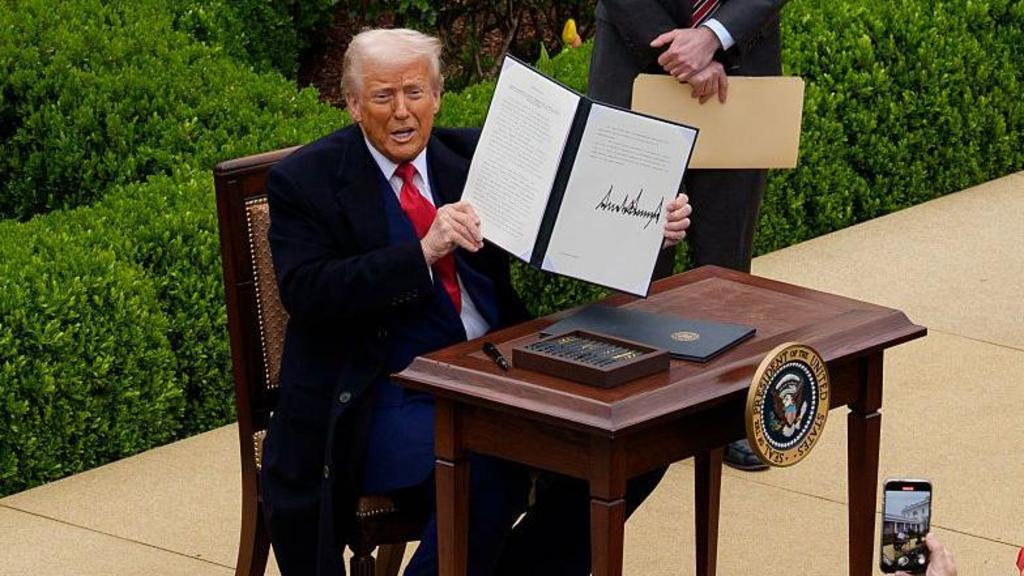President Donald Trump has announced plans to impose tariffs on goods entering the U.S. from 14 countries, including Japan and South Korea.
This latest escalation in global trade tensions from Trump comes as a 90-day pause, previously placed by the White House on some of its more aggressive import taxes, was set to expire.
The president unveiled plans for a 25% tariff on products from Japan and South Korea and shared letters to world leaders, warning of levies commencing from August 1.
Higher tariffs had been scheduled to take effect on July 9, but were previously suspended as White House officials stated they would pursue trade deals.
On Monday, Trump shared letters on social media addressed to leaders of 14 countries, informing them of the new tariff plans, while noting the rates could be adjusted “upward or downward, depending on our relationship with your country.”
The tariff rates outlined by Trump largely mirrored those proposed in April, when he made a “Liberation Day” announcement, threatening a wave of new taxes on goods from various nations.
The president argues that tariffs will shield American businesses from foreign competition and stimulate domestic manufacturing and job growth.
However, economists contend that these measures will increase prices in the U.S. and reduce trade. The three main U.S. share indexes experienced a downturn on Monday, with Toyota’s U.S.-listed shares falling by 4%.
Japan exported over $148 billion in goods to the U.S. last year, making it America’s fifth-largest import supplier, following the European Union (EU), Mexico, China, and Canada, according to U.S. trade data. South Korea was also among the top 10.
In addition to South Korea and Japan, Trump outlined plans on Monday for a 40% tariff on goods from Myanmar and Laos, a 36% tariff on goods from Thailand and Cambodia, a 35% tariff on goods from Serbia and Bangladesh, a 32% tariff on Indonesia, a 30% tariff on goods from South Africa, and a 25% tariff on goods from Malaysia and Tunisia.
White House press secretary Karoline Leavitt indicated that more letters may follow in the coming days.
She disputed the notion that shifting the tariff deadlines from July 9 to August 1 might diminish the impact of Trump’s threats.
“The president’s phone, I can tell you, rings off the hook from world leaders all the time who are begging him to come to a deal,” she stated.
When the president initially announced the steep tariffs in April, financial markets experienced turmoil, prompting him to suspend some of the highest duties to allow for negotiations, while retaining a 10% levy.
Treasury Secretary Scott Bessent said he anticipated “a busy couple of days.”
“We’ve had a lot of people change their tune in terms of negotiations. So my mailbox was full last night with a lot of new offers, a lot of new proposals,” he told CNBC.
Trump had initially characterized his April tariffs as “reciprocal,” asserting they were necessary to counter other countries’ trade regulations he deemed unfair to U.S. exports.
He has also announced tariffs for key sectors, such as steel and cars, citing national security concerns, and threatened to increase levies on other items, including pharmaceuticals and lumber.
These multi-layered policies have complicated trade discussions, with car tariffs being a significant point of contention in negotiations with Japan and South Korea.
To date, the U.S. has reached agreements with the UK and Vietnam, as well as a partial agreement with China. In all three cases, the agreements have raised tariffs compared to levels before Trump’s return to the White House, while key issues remain unresolved.
The U.S. has indicated that a deal with India is nearing completion.
The EU is also engaged in discussions, with reports suggesting officials within the bloc did not anticipate receiving a tariff letter. An EU spokesperson also noted that European Commission President Ursula von der Leyen had a “good exchange” with Trump.
Just weeks prior, the U.S. president had threatened the EU with a 50% tariff unless an agreement was reached.
Last week, Trump stated that Japan could face a “30% or 35%” tariff if the country failed to reach a deal with the U.S. by Wednesday.

